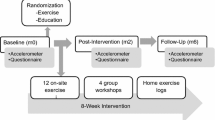Abstract
Physical inactivity increases the risk of many chronic diseases. Approximately 40% to 50% of college students are physically inactive. Research suggests that when students establish physical activity routines during their college careers, they have a greater chance of maintaining those specific behaviors over time. The current study sought to increase steps in sedentary college students by using a self-management intervention consisting of self-monitoring, goal setting, social media (Instagram), weekly meetings, and social feedback. Researchers used a multiple-baseline across-participants design with an embedded reversal to assess the effects of the packaged intervention. The intervention increased the physical activity levels of 3 of the 4 participants. The results of the current study suggest that multiple strategies such as the use of technological innovations, goal setting, and social media feedback should be considered and leveraged in programs aimed at increasing the level of physical activity among college students.



Similar content being viewed by others
References
Adámková, V., Belohoubek, J., Adámek, V., Juhanáková, M., & Pirk, J. (2015). Physical activity and exercise as a basic preventive measure (primary prevention, prevention after renal transplantation). Central European Journal of Public Health, 23, S3. https://doi.org/10.21101/cejph.a4014.
American College of Sports Medicine. (2018). ACSM issues new guidelines on quantity and quality of exercise. Retrieved from https://www.prweb.com/releases/2011/6/prweb8606343.htm
Brobst, B., & Ward, P. (2002). Effects of public posting, goal setting, and oral feedback on the skills of female soccer players. Journal of Applied Behavior Analysis, 35(3), 247–257. https://doi.org/10.1901/jaba.2002.35-247.
Center for Disease Control and Prevention. (2019a). Data and statistics. Retrieved from https://www.cdc.gov/physicalactivity/downloads/trends-in-the-prevalence-of-physical-activity-508.pdf
Center for Disease Control and Prevention. (2019b). Physical activity basics. Retrieved from http://www.cdc.gov/physicalactivity/everyone/measuring/index.html
Chartlytics. (n.d.). Retrieved July 30, 2020, from https://app.chartlytics.com/login
Cooper, J. O., Heron, T. E., & Heward, W. L. (2007). Applied behavior analysis (2nd ed.). Saddle River, NJ: Pearson Prentice Hall.
Feehan, L. M., Geldman, J., Sayre, E. C., Park, C., Ezzat, A. M., Yoo, J. Y., et al. (2018). Accuracy of Fitbit devices: Systematic review and narrative syntheses of quantitative data. Journal of Medical Internet Research, 20(8), 53. https://doi.org/10.2196/10527.
Hirvensalo, M., & Lintunen, T. (2011). Life-course perspective for physical activity and sports participation. European Review of Aging and Physical Activity, 8(1), 13. https://doi.org/10.1007/s11556-010-0076-3.
Keating, X. D., Guan, J., Piñero, J. C., & Bridges, D. M. (2005). A meta-analysis of college students’ physical activity behaviors. Journal of American College Health, 54(2), 116–126. https://doi.org/10.3200/jach.54.2.116-126.
Kraus, W., Janz, K., Powell, K., Campbell, W., Jakicic, J., Troiano, R., et al. (2019). Daily step counts for measuring physical activity exposure and its relation to health. Medicine & Science in Sports & Exercise, 51(6), 1206–1212. https://doi.org/10.1249/MSS.0000000000001932.
Kurti, A. N., & Dallery, J. (2013). Internet-based contingency management increases walking in sedentary adults. Journal of Applied Behavior Analysis, 46(3), 568–581. https://doi.org/10.1002/jaba.58.
LaLonde, K. B., MacNeill, B. R., Eversole, L. W., Ragotzy, S. P., & Poling, A. (2014). Increasing physical activity in young adults with autism spectrum disorders. Research in Autism Spectrum Disorders, 8(12), 1679–1684. https://doi.org/10.1016/j.rasd.2014.09.001.
Lee, I. M., Shiroma, E. J., Lobelo, F., Puska, P., Blair, S. N., Katzmarzyk, P. T., & Lancet Physical Activity Series Working Group. (2012). Effect of physical inactivity on major non-communicable diseases worldwide: An analysis of burden of disease and life expectancy. The Lancet, 380(9838), 219–229. https://doi.org/10.1016/S0140-6736(12)61031-9.
Lindsley, O. R. (1990). Precision teaching: By teachers for children. Teaching Exceptional Children, 22(3), 10–15. https://doi.org/10.1177/004005999002200302.
Office of Disease Prevention and Health Promotion. (2019). Appendix 1. Translating scientific evidence about total amount and intensity of physical activity into guidelines. Retrieved from https://health.gov/sites/default/files/2019-09/paguide.pdf.
Raudsepp, L., Neissaar, I., & Kull, M. (2008). Longitudinal stability of sedentary behaviors and physical activity during early adolescence. Pediatric Exercise Science, 20(3), 251–262. https://doi.org/10.1123/pes.20.3.251.
Santarossa, S., & Woodruff, S. J. (2018). #LancerHealth: Using Twitter and Instagram as a tool in a campus wide health promotion initiative. Journal of Public Health Research, 7(1), 1166. https://doi.org/10.4081/jphr.2018.1166.
Sparling, P. B., & Snow, T. K. (2002). Physical activity patterns in recent college alumni. Research Quarterly for Exercise and Sport, 73(2), 200–205. https://doi.org/10.1080/02701367.2002.10609009.
Van Camp, C. M., & Hayes, L. B. (2012). Assessing and increasing physical activity. Journal of Applied Behavior Analysis, 45(4), 871–875. https://doi.org/10.1901/jaba.2012.45-871.
Van Houten, R. (1980). Learning through feedback: A systematic approach for improving academic performance. New York, NY: Human Sciences Press.
VanWormer, J. J. (2004). Pedometers and brief e-counseling: Increasing physical activity for overweight adults. Journal of Applied Behavior Analysis, 37(3), 421–425. https://doi.org/10.1901/jaba.2004.37-421.
Author information
Authors and Affiliations
Corresponding author
Ethics declarations
Conflict of Interest
The authors declare that they have no conflict of interest.
Ethical Approval
All of the procedures in this study, which involved human participants, were conducted according to ethical standards of the institutional and/or national research committee and with the 1964 Helsinki declaration and its later amendments or comparable ethical standards. University institutional review board approval was obtained.
Informed Consent
Informed consent was obtained from all individual participants included in the study.
Additional information
Implications for Practice
• Intervention packages using self-management and social media are a viable option to increase physical activity without the use of tangible reinforcers.
• The cost-effectiveness of this intervention may be applicable at a larger scale to decrease physical inactivity in college students.
• Individualized interventions may be used for the few who do not respond to the universal intervention.
Publisher’s Note
Springer Nature remains neutral with regard to jurisdictional claims in published maps and institutional affiliations.
This project was funded by Georgia Southern University’s Graduate Student Organization. We thank Dr. Jennifer Wertalik and Dr. Erin Frick for providing us with their valuable feedback and assistance during data collection. Special thanks go to Dr. Joshua L. Williams and Ms. Sheryl Powell for allowing us to conduct the weekly meetings in the Psychology Department. Lastly, we extend deep thanks to Dr. Nancy McCarley for her thoughtful edits on previous versions of this article.
Rights and permissions
About this article
Cite this article
Junaid, H., Bulla, A.J., Benjamin, M. et al. Using Self-Management and Social Media to Increase Steps in Sedentary College Students. Behav Analysis Practice 14, 734–744 (2021). https://doi.org/10.1007/s40617-020-00445-8
Published:
Issue Date:
DOI: https://doi.org/10.1007/s40617-020-00445-8




